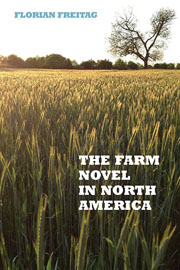 The Farm Novel in North America
The Farm Novel in North America Published online by Cambridge University Press: 05 December 2013
Spurred by debates and new ideas about women, their work, and their role within society, North American farm novels at the beginning of the twentieth century started to investigate more closely the role of women on the farm. Starting in the early 1900s and especially during the 1910s and 1920s, the genre increasingly focused on female protagonists and created new fictional types and plot formulas especially around unmarried women characters who dedicate their lives to the soil.
In the United States, single women farmers already appeared in Eleanor Gates's The Plow-Woman (1906) and Hamlin Garland's The Moccasin Ranch: A Story of Dakota (1909); but it was Willa Cather's O Pioneers! ([1913] 1993), with its protagonist Alexandra Bergson, that featured the clearest and perhaps also the most memorable example of the figure of pioneer heroine in American farm fiction. English Canadian rural idylls, such as Arthur Stringer's The Prairie Wife (1915) and particularly Evah McKowan's Janet of Kootenay (1919), also drew on this new fictional type and simultaneously added elements of the so-called “new woman” to it. One year after Cather's novel, Louis Hémon's Maria Chapdelaine ([1914] 1921) introduced a new plot formula to the French Canadian farm novel, which focused on a young woman's choice between different suitors who were each inextricably linked with one of the roman de la terre's deterministic geographies. Slowly but surely, this new plot formula would be both imitated and reconfigured by later works, such as Harry Bernard's La terre vivante (1925) and Félix-Antoine Savard's Menaud, maître-draveur ([1937] 1992).
To save this book to your Kindle, first ensure [email protected] is added to your Approved Personal Document E-mail List under your Personal Document Settings on the Manage Your Content and Devices page of your Amazon account. Then enter the ‘name’ part of your Kindle email address below. Find out more about saving to your Kindle.
Note you can select to save to either the @free.kindle.com or @kindle.com variations. ‘@free.kindle.com’ emails are free but can only be saved to your device when it is connected to wi-fi. ‘@kindle.com’ emails can be delivered even when you are not connected to wi-fi, but note that service fees apply.
Find out more about the Kindle Personal Document Service.
To save content items to your account, please confirm that you agree to abide by our usage policies. If this is the first time you use this feature, you will be asked to authorise Cambridge Core to connect with your account. Find out more about saving content to Dropbox.
To save content items to your account, please confirm that you agree to abide by our usage policies. If this is the first time you use this feature, you will be asked to authorise Cambridge Core to connect with your account. Find out more about saving content to Google Drive.